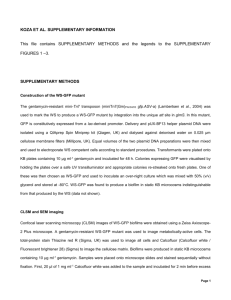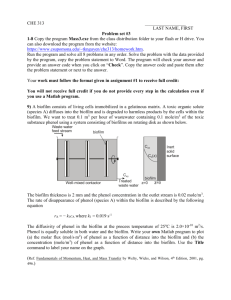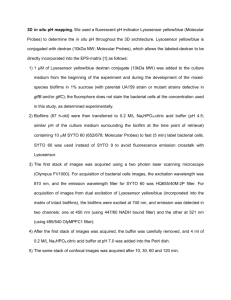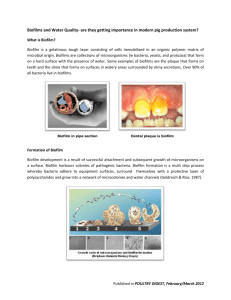Micorbial biofilm architecture reflects distinct organismal
advertisement
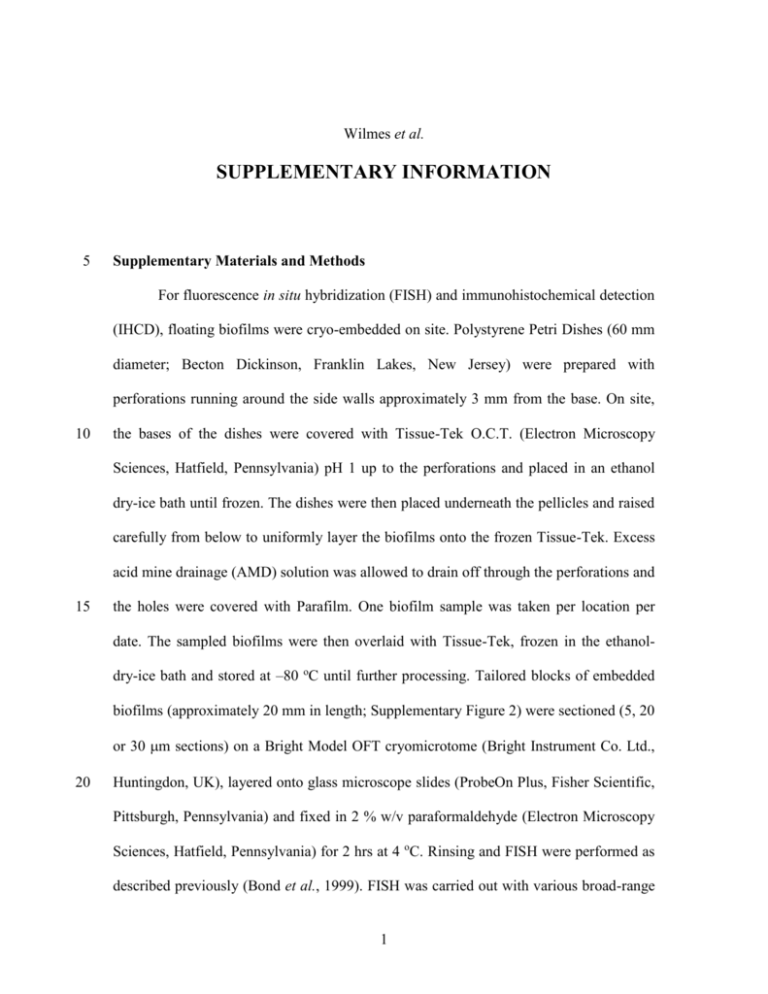
Wilmes et al. SUPPLEMENTARY INFORMATION 5 Supplementary Materials and Methods For fluorescence in situ hybridization (FISH) and immunohistochemical detection (IHCD), floating biofilms were cryo-embedded on site. Polystyrene Petri Dishes (60 mm diameter; Becton Dickinson, Franklin Lakes, New Jersey) were prepared with perforations running around the side walls approximately 3 mm from the base. On site, 10 the bases of the dishes were covered with Tissue-Tek O.C.T. (Electron Microscopy Sciences, Hatfield, Pennsylvania) pH 1 up to the perforations and placed in an ethanol dry-ice bath until frozen. The dishes were then placed underneath the pellicles and raised carefully from below to uniformly layer the biofilms onto the frozen Tissue-Tek. Excess acid mine drainage (AMD) solution was allowed to drain off through the perforations and 15 the holes were covered with Parafilm. One biofilm sample was taken per location per date. The sampled biofilms were then overlaid with Tissue-Tek, frozen in the ethanoldry-ice bath and stored at –80 oC until further processing. Tailored blocks of embedded biofilms (approximately 20 mm in length; Supplementary Figure 2) were sectioned (5, 20 or 30 m sections) on a Bright Model OFT cryomicrotome (Bright Instrument Co. Ltd., 20 Huntingdon, UK), layered onto glass microscope slides (ProbeOn Plus, Fisher Scientific, Pittsburgh, Pennsylvania) and fixed in 2 % w/v paraformaldehyde (Electron Microscopy Sciences, Hatfield, Pennsylvania) for 2 hrs at 4 oC. Rinsing and FISH were performed as described previously (Bond et al., 1999). FISH was carried out with various broad-range 1 oligonucleotide probes [ARC915 (archaea; Amann et al., 1995), EUBMIX (bacteria; Daims et al., 1999) and EUKMIX (eukarya; Baker et al., 2003)], and more specific probes [LF655 (Leptospirillum groups II and III; Bond and Banfield, 2001), LF1252 (Leptospirillum group III; Bond and Banfield, 2001), TH1187 (Thermoplasmatales; Bond 5 and Banfield, 2001)]. Probes were labeled with any of the following fluorochromes: FITC, CY3 or CY5. For each sampling site, date and probe combination, six biofilm coss-sections were prepared and hybridized. At C12, around 20 mm long transects were prepared to cover the individual developmental stages (Supplementary Figure 2). For simultaneous FISH and IHCD of Cyt579, 5 m biofilm thin-sections were permeabilized 10 for 30 min in lysozyme solution (5 mg per ml of TE buffer) and for 15 min in proteinase K solution (1 g per ml of TE buffer). Following FISH (using FITC and CY5 labeled probes), a Cyt579-specific monoclonal antibody [raised in mice using the purified, native Cyt579 protein (Singer et al., 2008)] was applied at appropriate titer for 1 hr followed by washing each slide three times in 10 mM sodium phosphate, 150 mM NaCl solution at 15 pH 7.4 (PBS) and once in purified water for 3 min each. Secondary antibody detection was carried out in the dark for 1 hour with a Cy3-Goat Anti-Mouse IgG (H+L) conjugate (Invitrogen, Carlsbad, California) at 1 mg per ml of 10 % v/v normal goat serum in PBS. Biofilm thin-sections were stained with 4',6-diamidino-2-phenylindole (DAPI) and observed on a standard epifluorescent microscope (Leica DMRX, Leica Microsystems 20 Inc., Bannockburn, Illinois) and/or on a confocal laser scanning microscope (CLSM; Zeiss LSM 510 META, Carl Zeiss MicroImaging Inc., Thornwood, New York). For each sampling site and date, six biofilm transects were prepared and hybridized. Seven zstacks were generated at random on the CLSM per microbial population, per 2 development stage and per date. 3D image stacks were processed with IMARIS (Bitplane AG, Zürich, Switzerland) and daime (Daims et al., 2006). The different populations were quantified in 20-30 m thick z-stacks using the biovolume function in daime according to the instructions in the User Manual. The exported biovolume data were analyzed using 5 two-way analysis of variance (ANOVA) with replication using Microsoft Excel. For transmission electron microscopy (TEM), mature biofilm samples from C12 were layered onto Isopore membrane filters (0.4 m HTTP type; Millipore Corporation, Temecula, California). The filters were layered onto perforated Petri dishes, which allowed for the precise sampling of biofilms and draining of excess AMD solution. Filter- 10 supported biofilm samples were transferred into 150-200 m deep TYPE A aluminium planchettes (Leica Microsystems GmbH, Wetzlar, Germany) that were sandwiched against the flat side of TYPE B planchettes. The specimens were cryofixed in a Bal-Tec HPM010 High Pressure Freezer (2100 bar, 5-7 msec; Bal-Tec Inc., Carlsbad, California; Müller and Moor, 1984). Using the Leica automated freeze substitution system AFS 15 (Leica Microsystems, Vienna, Austria), cryofixed specimens were freeze-substituted in anhydrous acetone containing 1 % w/v osmium tetroxide/0.1 % w/v uranyl acetate and infiltrated with Epon-Araldite following established protocols (McDonald, 2007). Specimens were flat-embedded between two glass microscopy slides and polymerized at 60 °C for 1-2 days (Müller-Reichert et al., 2003). Resin-embedded biofilm samples were 20 remounted under a dissecting microscope for precise orientation. 100-120 nm thin sections were collected on Formvar-coated slot grids (Electron Microscopy Sciences) and post-stained with 2 % w/v uranyl acetate in 70 % v/v methanol followed by either Reynold’s or Sato’s lead citrate. Four serial sections of ~150 nm thickness of the biofilm 3 in cross-section were imaged at a magnification of 3,000x on an FEI Tecnai 12 TEM (FEI, Eindhoven, The Netherlands) using Kodak 4489 film. Films were scanned at 135 pixels per m. Individual images of each section were combined into a montage to cover the entire biofilm cross-section. The four montages were superimposed using Adobe 5 Photoshop and corresponded to a ~600 nm thick slab. Different cell types were distinguished based on cell shape (bacterial spirilla versus archaeal cocci), size as well as presence or absence of a pronounced S-layer (Bond et al., 2000). Bacterial, archaeal and eukaryal cells were quantified and colored according to their taxonomic affiliation. 10 Supplementary References Amann RI, Ludwig W, Schleifer KH (1995). Phylogenetic identification and in situ detection of individual microbial cells without cultivation. Microbiol. Mol. Biol. Rev. 59: 143-169. Baker BJ, Hugenholtz P, Dawson SC, Banfield JF (2003). Extremely acidophilic protist 15 from acid mine drainage host Rickettsiales-lineage endosymbionts that have intervening sequences in their 16S rRNA genes. Appl. Environ. Microbiol. 69: 5512-5518. Bond PL, Erhart R, Wagner M, Keller J, Blackall LL (1999). Identification of some of the major groups of bacteria in efficient and nonefficient biological phosphorus removal activated sludge systems. Appl. Environ. Microbiol. 65: 4077-4084. 20 Bond PL, Druschel GK, Banfield JF (2000). Comparison of acid mine drainage microbial communities in physically and geochemically distinct ecosystems. Appl. Environ. Microbiol. 66: 4962-4971. Bond PL, Banfield JF (2001). Design and performance of rRNA targeted oligonucleotide 4 probes for in situ detection and phylogenetic identification of microorganisms inhabiting acid mine drainage environments. Microb. Ecol. 41: 149-161. Daims H, Bruhl A, Amann R, Schleifer KH, Wagner M (1999). The domain-specific probe EUB338 is insufficient for the detection of all bacteria: development and 5 evaluation of a more comprehensive probe set. Syst. Appl. Microbiol. 22: 434-444. Daims H, Lücker S, Wagner M (2006). daime, a novel image analysis program for microbial ecology and biofilm research. Environ. Microbiol. 8: 200-213. McDonald K (2007). Cryopreparation methods for electron microscopy of selected model systems. Methods Cell Biol. 79: 23-56. 10 Müller M, Moor H (1984). Cryofixation of thick specimens by high-pressure freezing. In: Revel JP, Barnad T and Haggis GH (eds). The Science of Biological Specimen Preparation for Microscopy and Microanalysis. Scanning Electron Microscopy Inc.: O'Hara. pp 131–138. Müller-Reichert T, Hohenberg H, O'Toole ET, McDonald K (2003). Cryoimmobilization 15 and three-dimensional visualization of C. elegans ultrastructure. J. Microsc. 212: 71-80. Singer SW, Chan CS, Zemla A, VerBerkmoes NC, Hwang M, Hettich RL et al (2008). Characterization of cytochrome 579, an unusual cytochrome isolated from an iron oxidizing microbial community. Appl. Environ. Microbiol. 74: 4454 - 4462. 5 Supplementary Table 1 pH and temperature measurement results of the AMD solutions underlying the sampled biofilms at both locations on the three distinct sampling dates. C12 C75 Date pH Temperature / oC pH Temperature / oC 6-Nov-06 1.01 39.5 1.03 40 2-May-07 1.14 39.3 1.17 44.4 7-Nov-07 0.96 24 0.91 41.5 6 Supplementary Figure 1 Richmond Mine sampling sites: (I) C12, (II) C75. Direction of acid mine drainage flow indicated by grey arrows. 7 Supplementary Figure 2 Embedded biofilm. (a) Top view of cryo-embedded C12 biofilm in Petri Dish. Magnified area represents an excised transect block with the individual developmental stages highlighted in color. (b) Cartoon of Petri Dish with 5 individual developmental stages highlighted according to the color scheme used in a. 8 Supplementary Figure 3 Leptospirillum group III in developmental stage 2 biofilm at C12. (a) 3D CLSM FISH micrograph of Leptospirillum groups II and III. (b) FISH micrograph of a typical Leptospirillum group III microcolony and (c) of single 5 Leptospirillum group III cells. Micrograph color-coding: Leptospirillum group II, Leptospirillum group III. Scale bars, 1 m. 9 Supplementary Figure 4 Micrograph of immunohistochemical detection of Cyt579 in C12 developmental stage 1 biofilm. This section was prepared identically to the C75 section in Figure 2c. Scale bar, 10 m. 10


